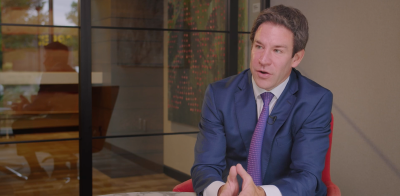He’s making a list (of cash and T-bills)
Since the holiday season is now upon us, it’s time to reflect on how lucky we all are to be hopefully healthy, happy and at least relatively wealthy.
It is also a perfect time to contemplate where we are in economic and market cycles and, most importantly, to plan ahead for the most intelligent deployment of the astounding levels of cash and Treasury bills (T-bills) that most investors (both institutions and individuals) have accumulated over the past four years.
Where are we in the cycle?
Remarkably—after 525 bps of rate hikes, a 10-year Treasury yield that is still close to 3% higher than at the end of 2021, unprecedented Fed balance sheet contraction, historically extreme levels of money supply contraction, a substantially inverted yield curve for over a year and bank lending stagnating for over two quarters—the U.S. economy remains incredibly resilient.
The scenarios for future economic activity going forward really boil down to two plausible outcomes: We stay in the “Dare to Dream” environment for multiple years or we enter a mild recession at some point in the next six to eighteen months.
Recession or Dare to Dream
We won’t rehash all of the points we discussed in the previous Dare to Dream strategy notes, but here is a quick recap of each potential outcome.
- The Dare to Dream outcome: The combination of state and local government spending, business fixed investments, construction and residential housing investments (combined with labor hoarding) prevent the labor market from continuing to evolve from white-hot, to somewhere between red-hot and really warm (where we are today), to eventually cool to cold with a recession to follow. Consumption and inflation subside gradually from here to a reasonable level, and a recession is delayed for many years.
- The mild recession outcome: The labor market continues to weaken and consumption declines. That sets off the typical recessionary path of declining investment and hiring in the real economy, which accelerates labor market losses. The result is a mild recession, similar to 2001 or the early 1990s.
Let’s now explore the ramifications of these two potential economic scenarios on both fixed income (bonds) and equities.
What it could mean for fixed income
In the Dare to Dream scenario, the Fed would not cut meaningfully anytime soon as the pace of recent declines in inflation slowed. (And after hiking by 525 bps, is the 75 bps of cuts they have penciled in through next year that meaningful?)
The recent drop in yields in the 10-year Treasury bond from 5% to 3.95% would be at least partially reversed (if not fully reversed and then some) and investors with too much duration1 in their portfolio would likely take it on the chin once again from a classic bear steepener.
In the mild recession scenario, the Fed would finally start to cut interest rates, but would progress slowly. The Fed would eventually take the Fed Funds rate to around 3%, and the 10-year yield would drop to around 3.5%.
Remember, the best framework for evaluating the pace and magnitude of future Fed rate cuts continues to be the mirror image of the 2015 to 2018 hiking cycle, since in that period of time, the Fed wanted to make sure it had slayed the deflation demon. This time around, the Fed will definitely want to be certain it placed a solid wooden stake through the heart of the inflation vampire.
So, if you are long a bunch of duration and continue to add to it here, you are really, really, really rooting for a U.S. recession ASAP—and even if that recession occurs, you have much less upside than prior economic downturns.
On the other hand, if the Dare to Dream scenario continues to play out, at least you may earn a higher income level than three years ago—but your total return (including duration-driven price declines) may continue to disappoint to say the least!
What it could mean for equities
In the Dare to Dream scenario, earnings would continue to grow but at a modest pace. The Fed would continue to drain its balance sheet, money supply would continue to decline and equities would give back some portion of their 2023 multiple re-expansion.
Remember, we came into 2022 at a 21.2X forward multiple on the S&P, compressed down to 15.75 by October of 2022, and have now re-expanded back to 20X forward earnings! I would argue that this is the single biggest surprise of this unorthodox cycle so far. We have only been more expensive twice on an absolute basis: The dot-com bubble and the pandemic green-light-go environment.
And guess what? Modest earnings growth with multiple compression2 is exactly what has transpired since the end of 2021: Modest earnings growth has slightly overwhelmed the 1.2X in multiple compression and the S&P 500 Total Return (TR) Index is up about 1.5%.
Sounds a lot like a “sloppy, choppy mess.”
In the mild recession scenario, expected earnings growth of 11.3% in 2024 would turn into at least a 10% decline, and assuming there is no multiple compression (perhaps this is a dubious assumption, but it’s the holiday season so let’s be optimistic), the S&P 500 TR would drop by the difference between expectations and the actual outcome, or by around 20%+.
Certainly not the end of the world, but some would say this is a steep price to potentially pay for modest further upside in equities from here.
So, if you are long a bunch of beta and continue to add to it here, you are really, really, really rooting for the continuation of the Dare to Dream scenario—but must realistically understand that equity market gains of the kind we saw in 2009 through 2021 (and yet again in 2023) have limited further meaningful upside.
If the recession outcome comes to pass—well, we’ve all seen worse bear markets—but a 20%+ digger is even more annoying than the sloppy, choppy mess we might see a Dare to Dream scenario.
The asset allocation challenge: Cash and T-bills
Moving on to asset allocation challenges, it is now clear one of the biggest difficulties investors face going forward is how the heck to intelligently put to work the massive hoards of cash and T-bills that have been accumulated over the past four years.
The scale of the challenge and potential opportunity is enormous.
- Money market balances: Since the end of 2019, U.S. money market fund balances have swelled by approximately $2 trillion.
- Commercial bank deposits: Even after recent declines (driven partially by concerns over the health of weaker U.S. Banks and partially by higher yields available elsewhere), commercial bank deposits are still up by over $4 trillion since the end of 2019.
Given the fact that cash is typically perceived as a low risk asset (even though inflation rates have typically dwarfed cash yields since the global financial crisis (GFC) up until very recently), it stands to reason when you are moving capital out of cash (or money markets or T-bills) the first, second or third allocations should probably be distributed to investment strategies that only incrementally increase risk and volatility—while potentially significantly increasing returns.
Stay in the northwest quadrant of the efficient frontier3 but try and earn a better return!
As always, these decisions are made within a framework of asset allocation. But the first stop for cash deployment probably should not be highly volatile, high-risk investments.
Which, drum roll please, naturally, brings us to democratized alternative investments.
The evolving use case for alternatives
Remember, the whole point of democratized alternatives is to provide investors with return streams that have less volatility and lower correlation/sensitivity to mainstream asset classes.
After the dot-com bubble collapse, the main use case for alternatives was a replacement or complement to equities. Given how low bond yields had dropped by around 2016–2017 (and how much duration risk built up over time in fixed income markets), the main use case for alternatives had become a replacement or complement to fixed income.
So far, so good for the fixed income replacement/complement.
Now, going forward for at least the next several years, the main use case for alternatives will likely be as an investment strategy that can provide substantially better nominal and real (after accounting for inflation) compared to cash, money markets, and T-Bills without subjecting them to substantially more risk of loss or volatility.
Yes indeed, “The Time for the Right Alts is Still Now.”
Alternatives strategies that fit the bill
Speaking of which, here are a few democratized alternatives strategies at different points in the volatility/risk spectrum that fit this mandate to a tee.
Private Senior Secured Commercial Real Estate Lending
It’s a great time to be a private lender if you have dry powder to take advantage of both the Dare to Dream economic environment and the pullback in bank lending with only slightly lower potential return in a mild recession.
Senior Secured lending strategies backed by tangible, performing assets (in this case, primarily multifamily, lodging/hospitality and industrial properties) continue to be one of the most economically resilient income and total return strategies on the planet.
You’ll never make 15% in a year—but if total returns over 12 months are ever less than the risk free rate, then heaven help the U.S. economy and the rest of your portfolio!
Multi-Strategy Funds
Designed to generate low volatility, low correlation and high single-digit returns, multi-strategy funds that are leaning into robust cash flows continue to outperform cash and cash equivalents.
Cash flows and income are up a lot in some cases, as these strategies can benefit directly from a higher risk-free rate and take advantage of timely themes, such as a historically slow prepayment/refinancing environment in the residential mortgage market.
Middle Market Private Corporate Lending combined with Asset-Based Lending
By taking modestly more risk and volatility than senior secured commercial real estate (CRE), you could potentially generate modestly more income and total return in a Dare to Dream environment in clean vintage private corporate and asset backed loans. Just like in the CRE market, you could arguably earn a greater total return in the senior part of the capital structure than in the most junior part—equity. In the mild recession environment, total return will be slightly lower, but should still give risk free a run for its money (no pun intended).
Middle Market Private Equity with an emphasis on PE Secondaries
By definition, once you move away from debt instruments to equity investments, you are taking more risk—and this would certainly be a case of an “I want to deploy cash for meaningful growth/total return” mindset instead of “I want to deploy cash for more income/total return with only incrementally more risk”.
However, the dynamics in middle market private equity (PE) continue to be attractive relative to other growth strategies, particularly in limited partner (LP)- and general partner (GP)-led secondaries. Additionally, middle market private equity was one of the few strategies out there that has posted positive returns in both 2022 and 2023.
Dynamic Credit
Strategies that do not have to provide investors with daily liquidity can not only go after less liquid, higher yielding credit investments in the normal course of business (like CLOs), but can also ramp up risk in market dislocations (like a potential mild recession or a Fed balance sheet reduction driven correction) to amplify returns.
You will have to be able to potentially tolerate more volatility than the first four strategies mentioned here, but in turn, you could generate attractive income, with modest growth potential over time.
Where do alternatives fit in 2024?
When we first came up with the “Time for Alts is Now” campaign in October of 2021, the urgency for alternatives allocations was driven by a high degree of certainty that 60/40 investment portfolios were about to get hammered.
Then, when we evolved the thesis to be “The Time for the Right Alts is Still Now” coming into 2023, the urgency was that you had to be more selective with the Alts that you were allocating to, relative to 2022 (Credit REITs vs. Equity REITs for instance: “Roll Up the Capital Structure”).
Now, going into 2024, the urgency of The Time for the Right Alts is Still Now is less about replacing fixed income for instance, and more about finding intelligent alternatives to cash and T-bills.
But just make sure you are focused on the correct alternative strategies—whether it’s by capital structure, vintage, strategy breadth, volatility, middle market PE vs. mega cap leveraged buyout (LBO), or dynamic credit strategies by credit rating/risk profile.
And to all a good night
So go ahead, fight inertia and embrace the right alternatives to potentially increase income and total return while only modestly increasing risk and volatility relative to cash, money markets and T-Bills.
Happy Holidays!
Investing in alternatives is different than investing in traditional investments such as stocks and bonds. Alternatives tend to be illiquid and highly specialized. In the context of alternative investments, higher returns may be accompanied by increased risk and, like any investment, the possibility of an investment loss. Investments made in alternatives may be less liquid and harder to value than investments made in large, publicly traded corporations. When building a portfolio that includes alternative investments, financial professionals and their investors should first consider an individual’s financial objectives. Investment constraints such as risk tolerance, liquidity needs and investment time horizon should be determined.




